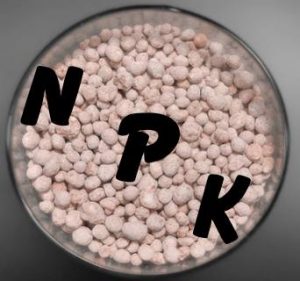Artificial or inorganic fertilisers are manufactured chemicals, usually from hydrocarbons or from mining minerals, and were responsible for a revolution in agriculture, increasing yields tremendously.
 Inorganic fertilisers tend to be cheap and compact, which reduces transport costs and simplifies distribution. They are also easily soluble in water, which means they are quickly available to the plants.
Inorganic fertilisers tend to be cheap and compact, which reduces transport costs and simplifies distribution. They are also easily soluble in water, which means they are quickly available to the plants.
Natural manures will add both nutrients and humus to the soil but are far bulkier. To apply 200Kg of nitrogen to a hectare of farmland would require the addition of 435Kg of prilled urea but 33,330Kg (33+ tonnes) of cow manure.
The negatives to artificial fertiliser use are that they are usually made from non-renewable resources with high energy input. The manufacturing processes are quite energy intensive. The production of ammonia (for nitrogen based fertilisers) consumes a surprising amount of the world’s natural gas – some report as high as 5%.
Ease of distribution and cheapness of nitrogen fertiliser has often resulted in over-use. That over-use produces sappy growth attractive to pests and run-off causing environmental damage.
This run-off damage occurs when excess nitrogen and phosphorus gets into streams and rivers and causes an increased growth in algae. The growth uses up the available oxygen in the water, killing the fish and destroying the ecosystem in a process called eutrophication.
Modern farmers, being very cost efficient, avoid this problem by using just the amounts of fertiliser required at the time required avoiding excess run-off which is wasteful.
Humus
Neither artificial or natural fertilisers add humus to the soil. Failure to provide animal or green manures and compost to the soil, just continued application of fertilisers, will eventually result in a collapse of the ecology of the soil. Lack of microbes who assist our plants in absorbing both the major and micro nutrients will reduce productivity Reduced numbers of earthworms will reduce aeration in the soil, which is also vital for plant growth. Eventually the soil structure collapses and yields collapse as well.
Artificial fertilisers are available in simple or straight forms, where just one element is supplied. They are also supplied as compound fertilisers where these chemicals have been mixed in various proportions to provide a balanced fertiliser.
National Growmore Fertiliser
The most famous balanced fertiliser was National Growmore. It was originally produced in the second world war as part of the Dig for Victory campaign. Now just called Growmore, it is the most popular generic compound fertiliser.
Some artificial fertilisers are supplied in prilled or granular forms. This makes them easier to handle and apply. Slow release fertilisers are the simple chemical coated in clay or other materials. This means they dissolve and release the fertiliser content over a period of time.
Making Your Own Fertiliser
It is perfectly possible to make your own fertiliser by mixing the straight ingredients to achieve a balanced fertiliser to your own needs.
For example, a typical potato fertiliser balance would be 7-5-12. This would be 7 parts of nitrogen to 5 parts of phosphorus and 12 parts of potash.
Using sulphate of ammonia at 20% nitrogen you would add 7 / 20% = 35g to cover the nitrogen, 5 / 18.5% = 27g of superphosphate and 12/50% = 24g of sulphate of potash. Usually you would mix this with 76g of fine dry sand and apply. (see NPK levels in fertiliser tables)
Various recipes are available in older gardening books. However specialist growers nowadays tend to buy ready made fertilisers, usually with added trace elements such as S-Chelate
Should you use artificial fertilisers?
Organic growers should not use artificial fertilisers by their general rules. In my opinion, conventional growers should, if possible, use composts and manures as their primary source of plant nutrients. Boost and balance with artificial fertilisers as necessary.
Forgetting the ecological concerns about the manufacture of artificial fertilisers, since it seems a better use of energy in any moral sense than flying away on holiday. However, artificial fertilisers do not improve the soil.
However they do not “poison the soil” and result in “low quality” produce, as some contend when correctly used.
Using composts and manures as a basis will improve the micro fauna of the soil. That will improve its ability to hold water, air and be a good environment for root growth.
Bloodmeal or dried blood (a natural fertiliser) has become increasingly difficult to obtain and expensive. Careful use of artificial fertilisers such as sulphate of ammonia will have basically the same effect.



